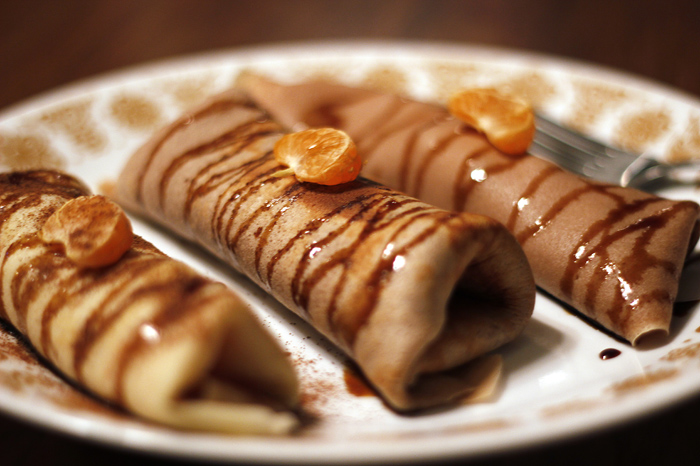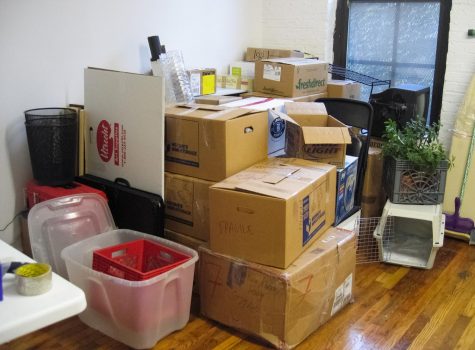Crêpes keep it creative
Three perfectly prepared crêpes sit ready for consumption at the apartment of Maxwell Reister, Monday, Jan. 20.
January 23, 2014
The word ‘crêpes’ is understandably unsettling to any true-blue, red-blooded American. The word sounds creepy and brings to mind French jazz nut jobs. But a plate of these really thin pancakes is practically irresistible to anyone with a functioning stomach.
Thinner than a pancake and tastier than a tortilla, crêpes are like edible wrapping paper that can hold a wide variety of tasty presents. They do require more cooking time than most students can afford on a school morning, but a large weekend batch will keep for a week. Crêpes are a simple yet impressive breakfast dish with equal parts adaptability and efficiency.
Crêpes require only a handful of common ingredients, a frying pan, a stovetop, and about half an hour. Choose a frying pan with a smooth and even cooking surface like stainless steel or cast iron. This helps the batter spread out smoothly and cook evenly. Thinner crêpes will cook all the way through without flipping, but it’s good to have a spatula on hand to coax stubborn crêpes out.
The key to crêpes is a smooth batter. Some recipes call for sifting the flour, but I have found this is usually more work than it’s worth. A satisfyingly smooth batter can be created by mixing wet and dry ingredients separately and then combining them using a metal whisk.
The true test of crêpe mastery is in the cooking. When the batter hits the pan, lift and tilt the pan so the batter evenly coats the bottom. If your batter is too runny or too thick, add flour or milk respectively. The thinnest possible crêpes will result from learning the least amount of batter required to cover your pan.
Crêpes usually work like a wrap by encasing your chosen filling in a warm spongy blanket. They work with sweet and savory ingredients and can be an effective way to use up leftovers. Crêpes are both container and food, and they can be rolled up to create a portable snack to munch on while waiting for the bus. You can also cover one side of a crêpe with rice or beans, sprinkle shredded cheese on top and then cover with another crêpe. Toast it in the oven and have yourself a crêpe quesadilla.
Because they are easy to freeze and reheat, crêpes can be made in large batches and saved for later. To freeze crêpes, first allow them to cool. Stack with a piece of plastic wrap between each crêpe or weave one long piece through a whole stack, which will keep the crêpes from sticking to each other. Place the stack in a sealed plastic bag and keep in the freezer. Reheat crêpes under a stove broiler, in a toaster oven, or in a microwave.
Crêpes are French in origin, but then again so are democracy and the Statue of Liberty. Even the legendary American race car driver Ricky Bobby admitted he’d like to crawl inside a stack of crêpes and eat his way out. Things that are different can be frightening but also delicious.
Ingredients (makes about eight crêpes)
• 1 cup all-purpose flour
• 2 eggs
• 1/2 cup milk
• 1/2 cup water
• 1/4 teaspoon salt
• 2 tablespoons butter or cooking oil
• Filling ideas: Nutella, chopped fruit, peanut butter, scrambled eggs, etc.
Directions
1. In a large mixing bowl, whisk together the milk, water and eggs. Gradually add in the flour and stir to combine smoothly. Add the salt and butter.
2. Heat a lightly oiled griddle or frying pan over medium to low heat (burner temps differ). Pour or scoop the batter onto the griddle using approximately 1/4 cup for each crepe. Tilt the pan with a circular motion so that the batter coats the surface evenly.
3. Cook the crepe for about 2 minutes until the top no longer looks wet and the edges start to lightly brown and curl. Invert the pan over serving plate and loosen the crepe with a flick of the wrist. If the crêpe refuses to drop, evacuate it with a spatula and add a teaspoon of oil to the pan.
4. Arrange filling in a horizontal line across the crêpe. Fold the left and right ends toward the center and then roll up from bottom to top. Or take two crêpes and fill sandwich-style.





















